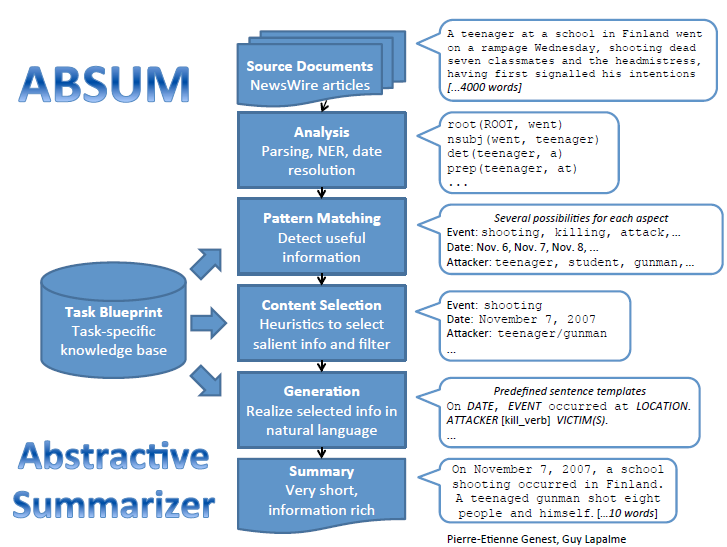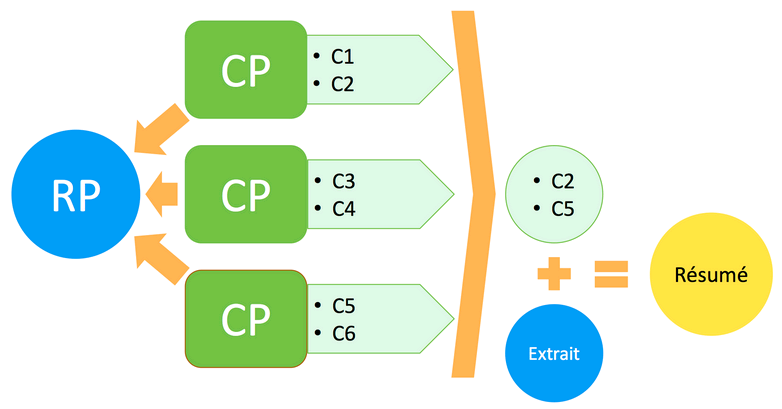Automatic summarization
Researchers at RALI, under the direction of Guy Lapalme, have been working in automatic summarization for many years.
Since 2002, RALI has participated in multiple competitions of Document Understanding Conference (DUC), more recently Text Analysis Conference (TAC).
Main landmarks:
- Horacio Saggion, in the late nineties, developed SumUM for summarizing scientific articles.
- SumUM was then adapted for CATS to summarize clusters of documents.
- Lakhas dealt with newspaper type documents in Arabic.
- LetSUM started a series of works on judicial documents.
- In 2007-2008, RALI in collaboration with NLP Technologies took part in the ASLI project dealing in great part on the automatic summarization of judgments.
- In 2009, RALI and NLP Technologies continued their collaboration with the ISASLI project.
- In his Ph.D. thesis, from 2010 to 2013, Pierre-Étienne Genest worked on abstractive summarization.
- From 2014 to 2017, Bruno Malenfant worked on citation based summarization.
SumUM
SumUM was developed by Horacio Saggion in his Ph.D. thesis(1997-2000). Horacio is now working as Ramon y Cajal Senior Research Fellow in the TALN Group at the Department of Information and Communication Technologies, Universitat Pompeu Fabra in Barcelona.
SumUM produces short summaries (10-15 lines) of long scientific documents (15-20 pages). SumUM produces a summary in two steps: first an indicative summary, which identifies important subjects of a document; then an informative summary is produced which elaborates a few subjects selected by the user.
The input to the system is a scientific article in English, containing the following structural elements: title, author and affiliation, introduction, main sections, conclusion, references and acknowledgments. The output of the system is a short indicative summary which is generated from information found in the original text. During evaluations, these have been found to be of comparable quality to summaries written by authors.
- SumUM site managed by Horacio Saggion
- Papers dealing with SumUM and more of Horacio Saggion work
For the DUC2002 summary evaluation competition, Atefeh Farzindar slightly modified SumUM without changing the algorithms or the syntactic patterns that were manually developed from a corpus study. Although the system was applied to a different type of text than the newspaper articles used for development, SumUM 's scores were among the best at DUC2002. For DUC2003, SumUM was again modified to deal with the summarization of multiple documents and again it scored very well.
CATS
CATS (Cats is an Automatic Text Summarizer) has been developed by Atefeh Farzindar and Frédérik Rozon during the summer of 2005 to take part in the Document Understanting Conference 2005 (DUC2005) competition. The task was to summarize in less than 250 words clusters of about 20 newspaper type articles dealing with similar events. The summary had to address a specific topic defined by question written in about 20 lines. CATS' performance, described in this article, was excellent compared with the thirty other systems that participated to the competition.
Lakhas

Fouad Douzidia has developed Lakhas (meaning summarize in Arabic), a summarization system for newspaper-type articles in Arabic based on a combination of methods that have only been used until now in English.
Lakhas has also been adapted for producing very short summaries (about ten words) for the DUC2004 evaluation. These Arabic summaries were then translated automatically into English. Although Lakhas followed a different track from the one proposed by the DUC organizers, its evaluation results were among the best ones at DUC2004. When we used the same translation system as the other participants, Lakhas' results were by far the best. These results are further described in this article and in his Masters Thesis.
LetSUM (Legal text Summarizer)
In collaboration with the LexUM, then a group at the Centre de recherche en droit public of the Law Faculty of Université de Montréal, Atefeh Farzindar has worked on the summarization of legal judgments. The approach exploits the thematic structure of judicial decisions in order to build a table-style summary; this improves coherence and readability of the summary. LetSUM allows jurists to rapidly consult the main ideas of a judgment in order to find appropriate jurisprudence. Atefeh defended her thesis in March 2005 and she has created an enterprise NLP Technologies to develop a legal document management system.
Automatic summarization of Legal Text (ASLI)
Between July 2007 and June 2008, NLP Technologies and RALI worked together on the ASLI (Automatic Summarization of Legal Information) research project funded by the Precarn Alliance Program).
Collaboration with the RALI dealt with two main aspects:
- Semantic rules of the legal field make it possible to segment a legal document, to identify the topics, to select the relevant sentences, to identify the category of the judgment and to determine the legal citations. The rules of legal field are dynamic and diversified; a general standard model must be developed. Moreover, during the design of the depository of information we must consider the maintainability: the ease with which the system can be modified to correct faults and improve performance.
More information about this aspect of the project :
- Article (in French) in Forum, November 2007.
- Emmanuel Chieze, Atefeh Farzindar and Guy Lapalme. Automatic Summarization and Information Extraction from Canadian Immigration Decisions. Proceedings of the Semantic Processing of Legal Texts Workshop, p. 51-57, may 2008 LREC 2008
- Emmanuel Chieze, Atefeh Farzindar and Guy Lapalme. An Automatic System for Summarization and Information Extraction of Legal Information. Accepted to Semantic Processing of Legal Texts.
- Development of a machine translator for judgements between French and English
More information about this aspect of the project
Intelligent system for Semantic processing and Automatic Summarization of Legal Information (ISASLI)
Between January and December 2009, with the financial support of Precarn, RALI and NLP Technologies collaborated to improve the summary revision system and to explore new statistical methods to help the adaptation of the system to new domains. This project also involved the participation of Palomino System Innovations Inc.
Collaboration with the RALI dealt with two main aspects:
- The development of RevSum a web based graphical interface to help the manual revision of automatic summaries which shows a combined vied of the original judgement and its automatic summary. It provides a simple sentence based interaction. This interface is now in production at NLP Technologies. It was then modified to create HexTAC used to create extractive summaries pour TAC2009 competition.
- Statistical summarization methods for judgements. Learning experiments were done on more than 4000 text-summary pairs.
More information is available in:
- Atefeh Farzindar et Mehdi Yousfi-Monod. RevSum - le logiciel Web d'aide à la révision de résumés automatiques. Présentation RALI-OLST, 23 juin 2009.
- Pierre-Etienne Genest, Guy Lapalme et Mehdi Yousfi-Monod. HEXTAC: the Creation of a Manual Extractive Run. Proceedings of TAC2009.
- Mehdi Yousfi-Monod, Atefeh Farzindar and Guy Lapalme. Supervised Machine Learning for summarizing Legal Documents. Proceedings of Canadian AI 2010, May 2010, Ottawa.
Abstractive summarization
Pierre-Étienne Genest participated in many TAC competitions (2008 to 2011), championing a symbolic approach to summarization, explained in his masters thesis (in French).
He then developed a fully abstractive automatic summarization system, in the news domain. It first extracts elements of information that are essential to the summary, separately for each category of document. Heuristics filter and select the content that will appear in the summary. Finally, a generation plan and generation patterns realize the natural language summary. This approach is described in an ACL2012 paper, then in his Ph.D. thesis defended in October 2013.

Abstractive summarization
In his Ph.D. thesis, Bruno Malenfant combines summarization techniques for helping scientific research. In order to build a summary from the information that other researchers have remembered from a given reference paper (RP), we will use the text surrounding the citations to the reference paper. The summary of the RP will thus be built from citation papers (CP), i.e. papers that cite it by first labeling them with a type such as aim, method, results, etc. The CPs are thus compared, commented and combined giving a new level of interpretation of the work of the RP that was not available at the time of writing. This set of citations are evidence of the contribution of this paper to the scientific community. More detail in his thesis (in French).


